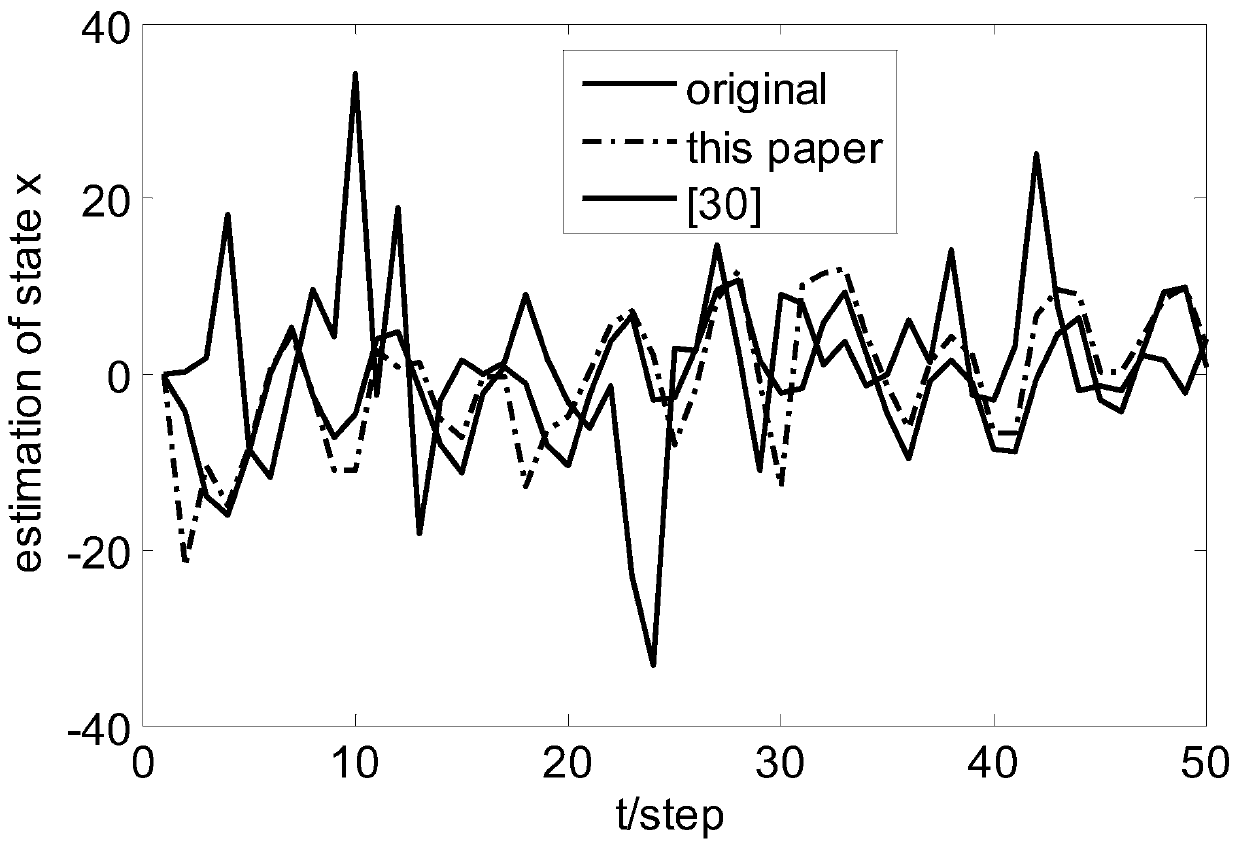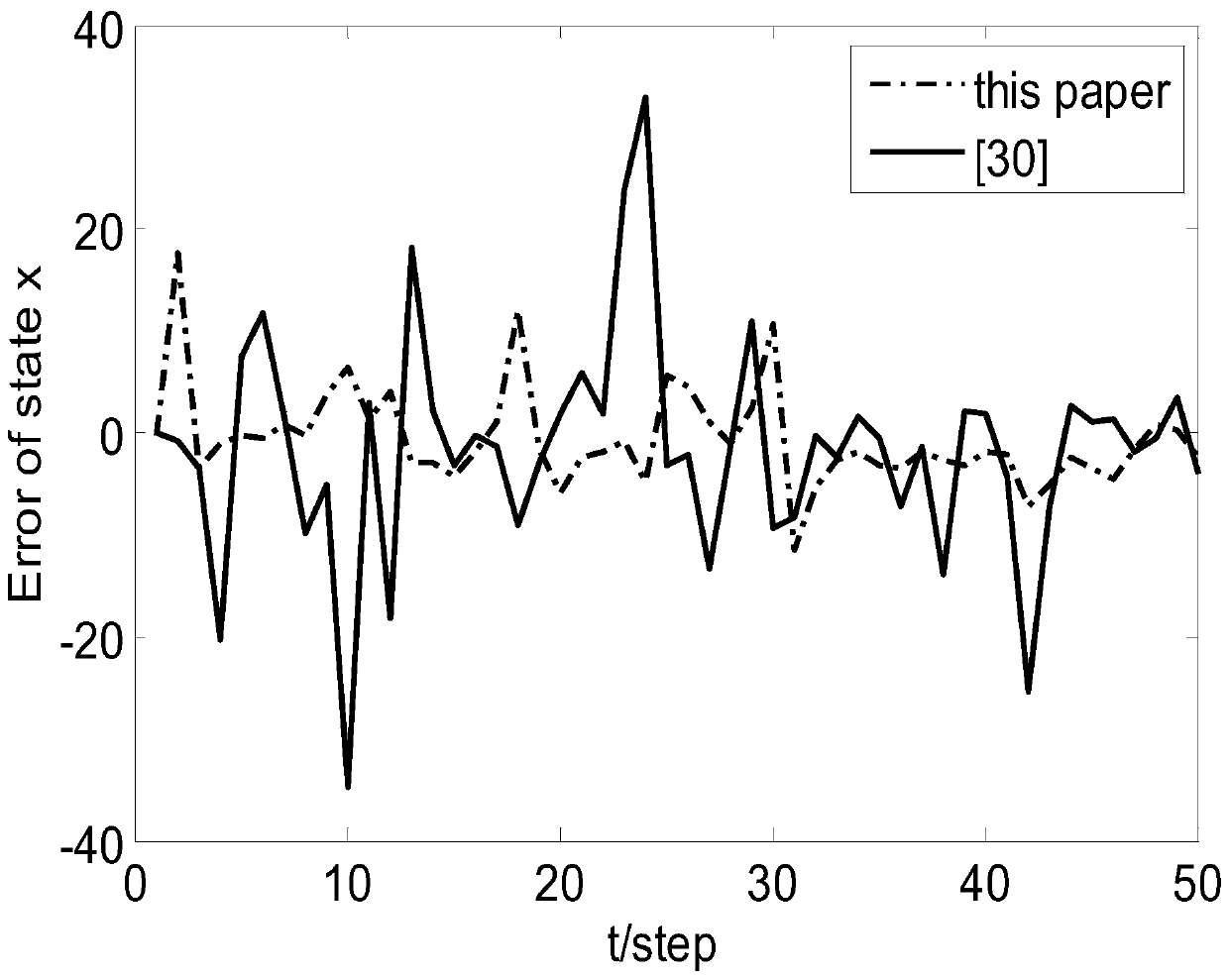Gaussian filtering method based on nonlinear network system under non-ideal condition
A network system and Gaussian filtering technology, applied in the field of state estimation of nonlinear systems, can solve problems such as divergence, decrease in filter estimation accuracy, and packet loss due to noise related to nonlinear network systems, so as to ensure stability and avoid divergence Effect
- Summary
- Abstract
- Description
- Claims
- Application Information
AI Technical Summary
Problems solved by technology
Method used
Image
Examples
specific Embodiment approach 1
[0025] Specific implementation mode 1: This implementation mode is based on the Gaussian filtering method of nonlinear network system under non-ideal conditions. The specific process is as follows:
[0026] Step 1. Establish a system model and a sensor measurement model;
[0027] Step 2. Provide assumptions and lemmas;
[0028] Step 3, designing a Gaussian filter based on step 2;
[0029] Step 4: Approximate the Gaussian weighted integral in Step 3 based on the third-order spherical diameter-volume rule to obtain the numerical form of the designed filter.
specific Embodiment approach 2
[0030] Specific embodiment two: the difference between this embodiment and specific embodiment one is that a system model and a sensor measurement model are established in the step one; the specific process is:
[0031] Model a nonlinear discrete-time system with correlated noise:
[0032] x k+1 =f(x k )+ω k (7)
[0033] Model a general nonlinear measurement:
[0034] z k =h(x k )+υ k (8)
[0035] where x k+1 is the system state at time k+1, x k is the system state at time k, x k ,x k+1 ∈ R n ,R n is n-dimensional real number space; z k is the sensor model at time k, z k ∈ R m ,R m is the m-dimensional real number space; f( ) and h( ) are known nonlinear functions; ω k ∈ R n and υ k ∈ R m is correlated zero-mean white Gaussian noise with covariance
[0036]
[0037] In the formula, δ kl is the Kronecker delta function, Q k and R k are process noise and measurement noise covariance respectively, S k is the cross-covariance, l is the moment l, ω l ∈...
specific Embodiment approach 3
[0042] Specific implementation mode three: the difference between this implementation mode and specific implementation mode one or two is that the assumption and lemma are given in the step two; the specific process is:
[0043] The corresponding assumptions and lemmas are given. The assumption is the premise of filter design, and the lemma is for the convenience of filter derivation;
[0044] Assumption 1. Assumption ω k ,υ k ,γ k and η k with x 0 irrelevant, and x 0 satisfy
[0045]
[0046] where x 0 is the initial value, is the estimated value of the initial value, E[] is the expectation, (·) T for T is transpose, is the initial value corresponding to the covariance;
[0047] Lemma 1. A=[a ij ] n×n is a real-valued matrix, B=diag{b 1 ,...,b n} and C=diag{c 1 ,...,c n} is a diagonal random matrix, defined
[0048]
[0049] In the formula, a ij is the i-th row and j-column element of A matrix, [a ij ] n×n The element of row i and column j is a ...
PUM
 Login to View More
Login to View More Abstract
Description
Claims
Application Information
 Login to View More
Login to View More - R&D
- Intellectual Property
- Life Sciences
- Materials
- Tech Scout
- Unparalleled Data Quality
- Higher Quality Content
- 60% Fewer Hallucinations
Browse by: Latest US Patents, China's latest patents, Technical Efficacy Thesaurus, Application Domain, Technology Topic, Popular Technical Reports.
© 2025 PatSnap. All rights reserved.Legal|Privacy policy|Modern Slavery Act Transparency Statement|Sitemap|About US| Contact US: help@patsnap.com



